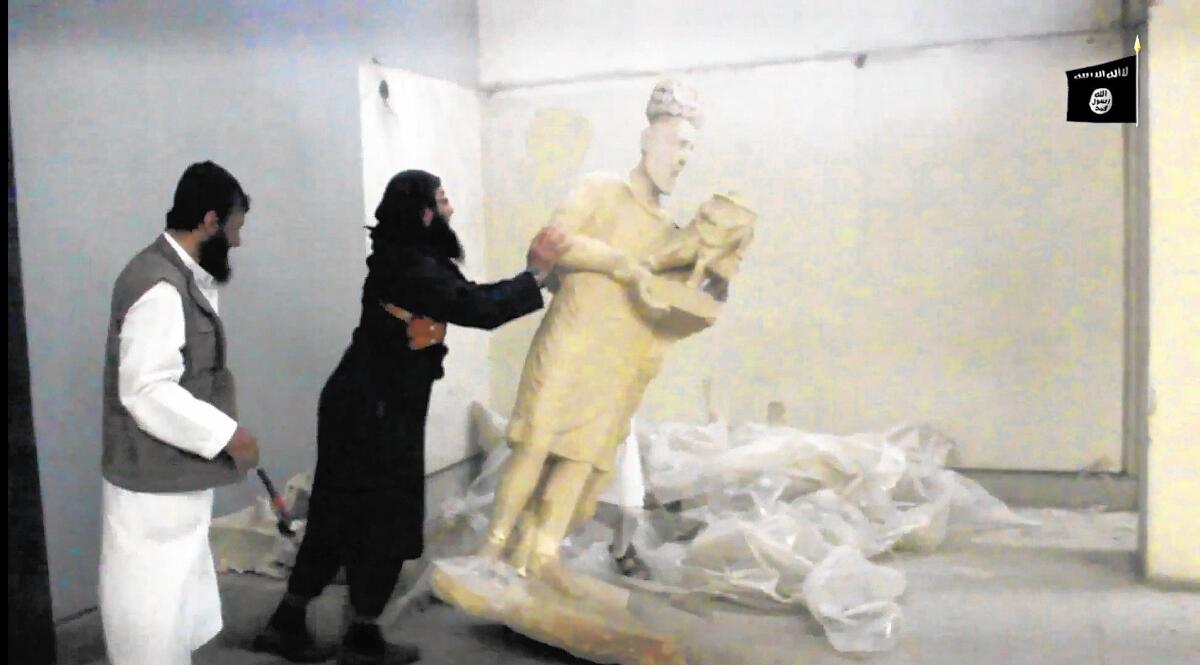The Mosul Museum video from Islamic State could be a staged drama

- Share via
The Islamic State wants the global community to know that there’s a new sheriff in town. So it wrecked a museum full of precious sculptures and on Thursday posted video of the vandalism on the Internet.
At least, that’s what their video wants you to think. The video quickly went viral, but there is reason for some skepticism.
Militants inside the Mosul Museum in northern Iraq are shown calmly going about the business of smashing 3,000-year-old statues from the ancient Assyrian empire and other historical dynasties. An on-camera narrator, citing verses from the Koran, confidently explains the destructive iconoclasm against pre-Muslim works of art as a necessary fulfillment of Muhammad’s dictum against the worship of false idols.
Earlier snuff videos from Islamic State, also known as ISIS or ISIL, show the beheading of soldiers, journalists and humanitarian aid workers. The new video purports to show nothing less than the beheading of an entire civilization.
The question is: Does it really? Or is the video, instead, a grotesque perversion of performance art, cynically designed to inflate the image of Islamic State power?
However genuine their belief system, the chilling, five-minute video incorporates extensive fabrication. It may well be a carefully staged, falsified dramatic event performed to create an effective propaganda tool to achieve important Islamic State goals.
Look closely, and most of the toppling statues shatter in clouds of dust. Apparently they are plaster replicas of ancient statues, not carvings in alabaster and other durable stone with which authentic imperial sculpture was made. Toppled stone would break in cleaner chunks.
Stone is an enduring material. Impressive examples of ancient Assyrian art are held in many major museums internationally, including the Los Angeles County Museum of Art. Five extraordinary alabaster reliefs from the inner walls of the palace of Ashurnasirpal II (883-859 BC) in modern-day Nimrud, just south of Mosul, have been among the collection’s preeminent works since LACMA acquired them in 1966.
From the Great Sphinx of Giza to the Lincoln Memorial in Washington, D.C., its use in monumental sculpture embodies power. It is meant to express aspirations toward permanence, sometimes vainglorious and sometimes noble. Obliterating a revered stone edifice says — in no uncertain terms — that radical change has arrived.
Visit the Getty Villa in Pacific Palisades and count the ancient Greek and Roman marble sculptures whose noses are smashed, their pagan claim to enduring ideal beauty whacked by subsequent armies of the self-righteous. That erasure is also why the Taliban blew up the 6th century Bamiyan Buddhas north of Kabul, Afghanistan, in 2001.
Stone is obdurate. Video is not. However, in YouTube culture digital art can be equally formidable. It spreads laterally and fast — then lingers in the electronic ether, available for endless replay.
Because Mosul is a war zone under Islamic State control, information on what actually happened at the museum is sketchy — and will remain so for some time. A similarly chaotic situation followed looting of the Iraq Museum in Baghdad during the 2003 American-led invasion.
Baghdad’s museum is a prime repository of civilization’s ancient cultural heritage, traced to the earliest settlements in the Tigris-Euphrates region. Invading American troops secured Baghdad’s massive oil ministry with 50 tanks and round-the-clock sharpshooters but, despite advance pleas from scholars, left the art museum defenseless. News of what was stolen, damaged or safe took months — and in some cases years — to discover.
Britain’s Channel 4 television gave the Islamic State propaganda video to archaeologists to examine. Mark Altaweel, an American scholar at the Institute of Archaeology at University College London, noted the modern iron rebar protruding from inside some of the smashed statues. It disproves their authenticity.
Nonetheless, the vandalism’s cultural insult strikes deep. The Iraqi people, Altaweel said, “are taking the destruction of their cultural heritage — their identity, essentially — just as seriously as the beheadings.”
And that is the point: The video is an incitement for its viewers, a blunt provocation for them to act.
On one hand, it is a bombastic recruitment tool, which beckons the disaffected to join fundamentalist religious fanatics in their supposedly glorious adventure.
On the other, it is an outrageous stick with which to poke the bear — including and perhaps especially the United States. The enemies of Salafist Muslim militants are essential to engage, if the cult’s apocalyptic endgame is to unfold. Abu Bakr Baghdadi, leader of Islamic State, would be pleased if we were shocked into intervening — boots on the ground — to guard our global cultural heritage.
Important antiquities have certainly been damaged or destroyed, including a monumental Assyrian statue of a winged bull-man that stood watch at one of the 15 gates to Ninevah. (In the video it looks like a lamassu, a human-animal protective deity, at the Nergal Gate.) Nineveh, once the largest city in the ancient world and long since a storied ruin across the Tigris River from Mosul, has been one of the 12 sites listed since 2010 by the Global Heritage Fund as being on the verge of irreparable loss.
Public libraries are being ransacked, modern books and old manuscripts from the Ottoman Empire burned. Punishment is death for attempting to hide or save artifacts. The iconoclastic sympathies of the self-declared caliphate should not be doubted.
Still, it is also true that taking a power drill or sledgehammer to a monumental stone sculpture does not make for what could be called, perversely and with a dry catch in the throat, “good TV.” Toppling statues in museum galleries and watching them smash on cold stone floors certainly does. Grandiose bluster is demanded of effective warrior propaganda that seeks to provoke.
Islamic State militants began occupying the Mosul Museum nearly eight months ago. The iconoclasm video they produced wasn’t posted until this week. Exactly when the smashing took place is not known, but the big gap between occupation and posting is worth pondering.
If the plan is to catapult the propaganda, timing matters. The ugly video is unprecedented — iconoclasm as Digital Age show business.
More to Read
The biggest entertainment stories
Get our big stories about Hollywood, film, television, music, arts, culture and more right in your inbox as soon as they publish.
You may occasionally receive promotional content from the Los Angeles Times.











